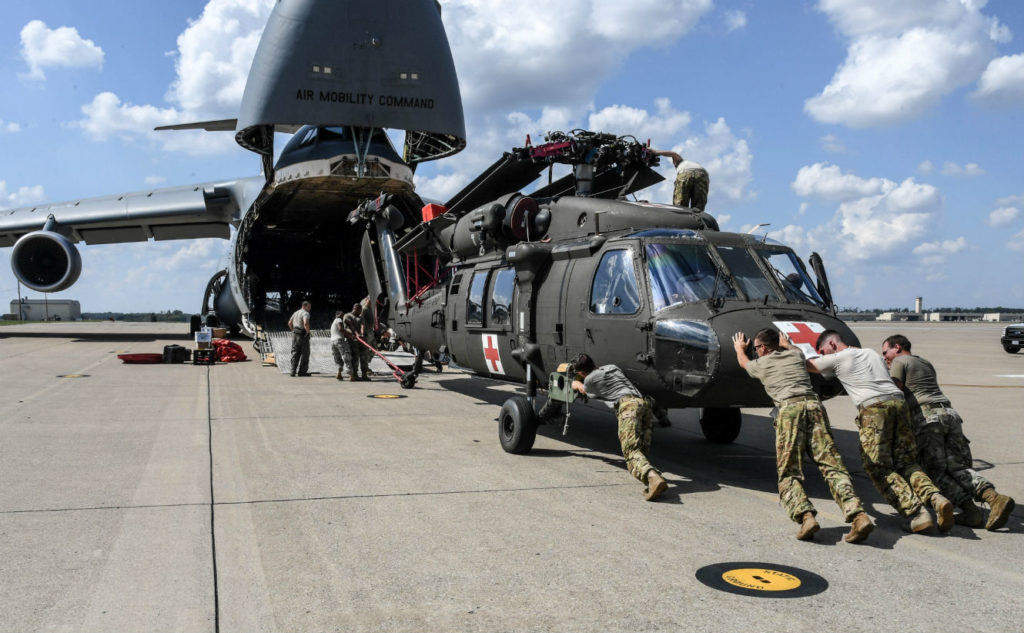Puerto Rico Shows Why the Army Needs to Look Beyond Helicopters

When disaster strikes, helicopters are in high demand. Hundreds participated in rescue efforts following Hurricane Katrina, and dozens more aided residents of Houston and Florida in the wake of Hurricanes Harvey and Irma. According to an interview with retired Lt. Gen. Russell Honore, who spearheaded Katrina relief efforts, nearly 80 helicopters were flying in the skies over Puerto Rico as of Saturday — perhaps less than half of what Honore estimates is necessary to mount an effective response to the widespread damage. The shortfall in helicopters wasn’t lost on San Juan Mayor Carmen Yulin Cruz, who was aghast that federal officials couldn’t figure out logistics for a small island.
The problem, of course, is “ocean water.” Puerto Rico lies nearly a thousand miles from Miami, and farther still from most Army bases, with few fuel stops in between. That’s much farther than a helicopter can fly on its own power, even with external fuel tanks. The Navy and Marine Corps can ship their helicopters, but the Army — which has the lion’s share of the Defense Department’s helicopters — has to physically load rotary-wing aircraft onto large Air Force cargo jets, taking up precious space that could be dedicated to food, water, and medical supplies.
The process is tedious and time-consuming. Only three of the Army’s UH-60 Black Hawk helicopters can fit onto a C-17 Globemaster, and this takes hours of folding and unfolding rotor blades and other parts. As for the CH-47 Chinook, only two can fit inside a C-5 Galaxy, the largest cargo plane in the Western world. Loading the helicopters onto the plane requires physically disassembling the rotor head and putting it back on, which takes nearly eight to ten hours per aircraft.
Performance-wise, the Army’s rotary-wing fleet has changed little in my lifetime. Though the digital cockpits and automatic flight control systems are certainly an improvement, engine power has increased only incrementally since the late 1970s, and upgraded engines are offset by add-ons and other modifications most aircraft accumulate over their lifetime. The Black Hawk helicopter alone has ballooned by over one ton since its inception, or 78 lbs per year.
The next crisis — be it a natural disaster or a war — may require the Army to move people and aircraft quickly over long distances. That means the Army needs to look at a future without helicopters, or “Future Vertical Lift,” as it’s called. Though no one is sure what this design will eventually look like, helicopter giants Bell and Sikorsky have offered two intriguing possibilities. The V-280 Valor from Bell Helicopter, maker of the venerable UH-1 Huey, is similar to the Marine Corps’ V-22 Osprey: It takes off like a helicopter, then tilts its rotors forward in flight to turn into a conventional airplane. Its main competitor is the SB-1 from Sikorsky and Boeing. Featuring two counter-rotating, or “coaxial,” rotor blades and a smaller “pusher” propeller to boost its forward airspeed, the SB-1 is based on Sikorsky’s X2 technology demonstrator, the fastest helicopter ever built.
Although both designs offer great improvements in speed and maneuverability, it’s their range that makes these aircraft revolutionary. Bell claims its design has a one-way range of over 2,000 nautical miles, similar to that of a light jet. That would make it capable of self-deploying to conflict zones and disaster areas without hitching a ride on ships or transport aircraft — not only giving the Army greater strategic range, but also freeing up valuable assets such as ships and cargo planes.
That said, the Army’s track record on modernization is the worst in the Defense Department, and Army Aviation is perhaps the worst offender. The Army poured over $7 billion into the failed RAH-66 Comanche stealth helicopter, then millions more into the ARH-70 Arapaho armed reconnaissance helicopter, while a third aircraft, the Armed Aerial Scout, never even materialized. And even if Future Vertical Lift does come to fruition, the Army’s current fleet of helicopters will have to make do until the middle of the century, with some Chinook airframes possibly living to be over 100 years old.
But if Army Aviation doesn’t find a replacement? It’ll find itself hitchhiking to get to the next fight.
Crispin Burke is an Army Aviator and a defense blogger. His views are his own and not those of the Defense Department.

